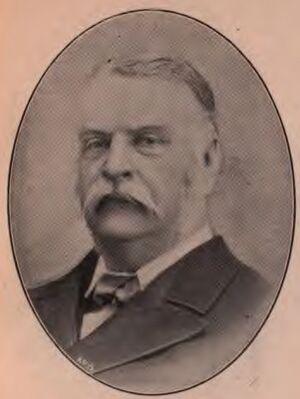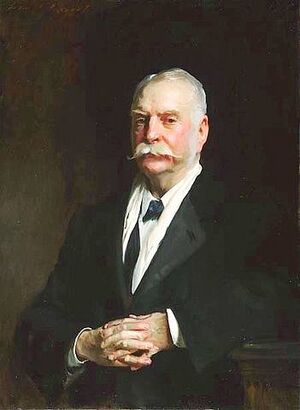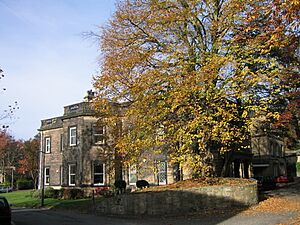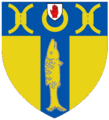James Kitson, 1st Baron Airedale facts for kids
James Kitson, 1st Baron Airedale (born September 22, 1835 – died March 16, 1911) was an important British businessman and politician. He built locomotives, which are engines for trains. He was also a member of the Liberal Party and served as a Member of Parliament for the Holme Valley. People knew him as Sir James Kitson from 1886 until 1907, when he became Lord Airedale. He was also a leading member of the Unitarian church in Leeds, Yorkshire.
Contents
Who Was James Kitson?
James Kitson was born to James Kitson (1807–1885) and his first wife, Ann. His father was a successful businessman who started a company called Kitson and Company, which built train engines. James had several brothers and sisters. His sister Emily married a doctor named William Smoult Playfair.
James Kitson went to school in Wakefield. He later studied chemistry and natural sciences at University College London.
Family Life and Challenges
In 1873, James Kitson's first wife, Emily, passed away. This was a very sad time for him. His sister-in-law, Clara Talbot, and her husband, Grosvenor Talbot, helped him a lot during this difficult period. They also looked after his children. James and Grosvenor were friends from college. Four years later, James's older brother, Frederick, who was a talented engineer, also died.
In 1885, Kitson bought a large house called Gledhow Hall in Gledhow, Leeds. He redecorated the house and often hosted grand parties. Important guests, like Prime Minister William Gladstone, visited his home. Gladstone's son, Herbert, was even a witness at Kitson's second marriage to Mary Laura Smith in 1881. Kitson even had a special bathroom made with beautiful tiles for a visit from the Prince of Wales around 1885.
What Did James Kitson Do?
James Kitson had a very successful career in business.
Building a Business Empire
When James Kitson was 19, in 1854, his father bought an ironworks factory called Monk Bridge. He put James and his older brother, Frederick, in charge of it. In 1858, Monk Bridge joined with their father's other factory, Airedale Foundry. By 1886, the business became a limited company, still controlled by the family, with a lot of money invested.
Frederick Kitson left the business due to poor health before he died in 1877. Their father retired in 1876, but James Kitson had been running the company since 1862. The Airedale Foundry built almost 6,000 train engines for use in Britain and other countries by the end of the 1800s. The company also started making other things, like engines for farms and steam engines for trams. From the 1880s, the Monkbridge factory began making steel using a special method. Both the Airedale Foundry and Monkbridge Works employed about 2,000 workers in 1911.
His Role in Industry
Because of his work, Kitson was a member of important engineering groups. He joined the Institution of Mechanical Engineers in 1859. He was also the president of the Iron Trade Association. In 1889, he became president of the Iron and Steel Institute. This institute gave him a special award, the Bessemer gold medal, in 1903. From 1899 to 1901, he was also part of the council for the Institution of Civil Engineers.
Kitson also had other business interests. He was involved with a shipping company and a banking company. He was a director at a major bank and president of an oil company. He was also a director of the North Eastern Railway Company and president of the Leeds Chamber of Commerce from 1880 to 1881.
Getting Involved in Politics
His success in business gave Kitson the time, money, and power to get involved in other areas, especially politics. He was the president of the Leeds Liberal Association. He also helped run the election campaign for William Ewart Gladstone, who became Prime Minister.
In 1880, Kitson was on a committee for the Leeds Trained Nurses Institution. He was elected as a Member of Parliament (MP) for Colne Valley from 1892 until 1907. As an MP, he supported better education, self-governance for Ireland, and the idea of providing old age pensions for people.
Awards and Titles
Kitson supported the Mechanics' Institute and the Yorkshire College, which later became the University of Leeds. The University of Leeds gave him an honorary doctorate degree in 1904. Even though Kitson was never a member of the Leeds City Council, he became the city's first Lord Mayor in 1896–1897.
He received the title of baronet in 1886. In 1906, he became a member of the Privy Council, a group of important advisors to the King or Queen. On July 17, 1907, James Kitson was given the title of the first Baron Airedale. This made him a peer, a member of the British nobility. He was also made an Honorary Colonel of a military battalion in 1902.
How Did James Kitson Die?
Lord Airedale died from a heart attack in Paris on March 16, 1911. He was on his way home by train from the south of France. His funeral was held at Mill Hill Chapel on March 22. His body was then taken for burial to Roundhay Church. About 4,000 workers lined the route to pay their respects. A memorial service was also held in London, attended by many Members of Parliament.
Mill Hill Chapel Connection
The Kitson family had a strong connection to Mill Hill Chapel in Leeds City Square. In 1897, Kitson paid for an extension to the chapel. A famous designer, William Morris, created a window for the chapel in memory of Kitson's mother, Ann Kitson, who died in 1865. Another artist, Archibald Keightley Nicholson, made a memorial window for Lord Airedale.
In the early 1900s, Lord Airedale was part of a small but very important group of people at the chapel who were active in politics. Kitson also helped with a government investigation into religious education for non-Anglican Protestants in 1899.
James Kitson's Family
James Kitson married Emily Christina Cliff on September 20, 1860. Emily helped start the Yorkshire Ladies Council of Education. James and Emily had several children:
- Sir Albert Ernest Kitson, 2nd Baron Airedale (1863–1944)
- James Clifford Kitson (December 6, 1864 – September 25, 1942)
- Charles Clifford Kitson (twin of James Clifford, born December 6, 1864)
- Emily (born 1866)
- Edward Christian (born 1873)
- (Alice) Hilda (1872–1944)
Kitson married Mary Laura Smith (died 1939) on June 1, 1881. They had two children:
- Sir Roland Dudley Kitson, 3rd Baron Airedale (1882–1958)
- Olive Mary (born 1887)
Kitson Family and Leeds Mayors
Several members of the Kitson family served as mayor or Lord Mayor of Leeds:
- In 1860 and 1861, James Kitson (Lord Airedale's father) was Mayor.
- In 1896 and 1897, his son, Sir James Kitson MP (who later became the 1st Baron Airedale), was the first Lord Mayor.
- In 1908 (and briefly in 1910), Frederick J Kitson, Lord Airedale's nephew, was Lord Mayor.
- In late 1942, Jessie Beatrice Kitson (born 1877), who was Lord Airedale's niece, became Lord Mayor after the elected mayor died.
Images for kids






